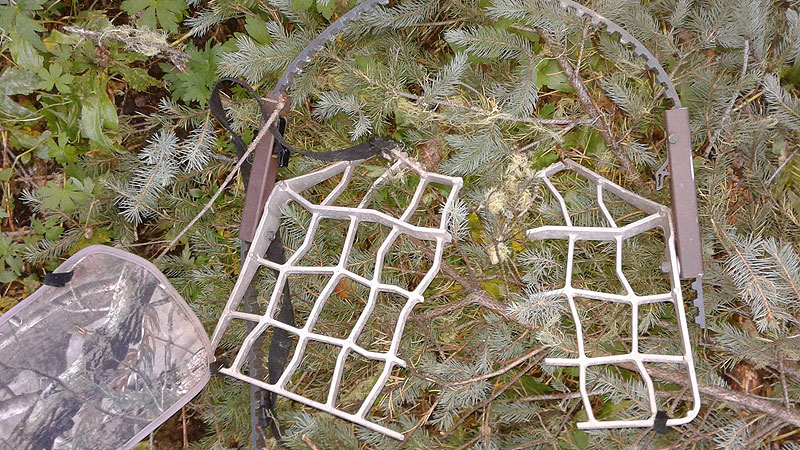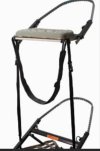So l heard of a few breaking after years of use. Is there a common reason or simply it's not meant for the stress of being stand on all the time? I figured that tree stand seat can take a lot of weight since a seat portion is where most of your weight is focused on. So are they breaking because of the pressure at certain angles when we're maneuvering in the tree?
-
The SH Membership has gone live. Only SH Members have access to post in the classifieds. All members can view the classifieds. Starting in 2020 only SH Members will be admitted to the annual hunting contest. Current members will need to follow these steps to upgrade: 1. Click on your username 2. Click on Account upgrades 3. Choose SH Member and purchase.
-
We've been working hard the past few weeks to come up with some big changes to our vendor policies to meet the changing needs of our community. Please see the new vendor rules here: Vendor Access Area Rules
You are using an out of date browser. It may not display this or other websites correctly.
You should upgrade or use an alternative browser.
You should upgrade or use an alternative browser.
What causes the Lone Wolf hand climber to fail as a saddle climbing platform?
- Thread starter HuumanCreed
- Start date
Going on over 4 years same LWHC, no failure. My guess would be guys with total weight above 250.
- Joined
- Jan 17, 2019
- Messages
- 6,279
If I recall, they tend to break at the bolt hole where the band attaches to the cast seat. One thing is that it is a cast platform. If it were machined out of a billet, then I'm guessing the chances of a weak spot goes down. Also, the seats, if I recall, on stands do not have to be rated as highly as the platform. I guess the thinking is if used as intended then if the seat breaks then you're still standing on the platform (and I guess you can call someone to get you down if you can't figure that one out using your tether, etc).
- Joined
- Jan 17, 2019
- Messages
- 6,279
IDK, Maybe bigger guys climbing small diameter trees? Puts more side pressure on traction belt arms.
this whole climbing thing is one time when i'm glad i'm not built like an NFL player
your post made me think of the intended weight distribution
when using the seat as a saddle platform, i think you're more likely to put full weight on the edge of the seat furthest from the tree
that is a lot different than your rear end sitting on the seat or when you climb as intended with your forearms across the seat
i think there's probably a lot more leverage on that pivot once you put full weight on the outside edge
- Joined
- Jan 17, 2019
- Messages
- 6,279
When I climbed with mine I used the seat climbing strap option.
It put all my weight on the two outside corners.
But all of your weight on one corner has to be worse.View attachment 95794
good call....leaning around the tree with 200 lbs on one corner is probably something the seat wasn't tested for
Not sure what happened to this one.If I recall, they tend to break at the bolt hole where the band attaches to the cast seat. One thing is that it is a cast platform. If it were machined out of a billet, then I'm guessing the chances of a weak spot goes down. Also, the seats, if I recall, on stands do not have to be rated as highly as the platform. I guess the thinking is if used as intended then if the seat breaks then you're still standing on the platform (and I guess you can call someone to get you down if you can't figure that one out using your tether, etc).

Here is the story.

 www.louisianasportsman.com
www.louisianasportsman.com

Tree stand malfunctions - Louisiana Sportsman
By always wearing a safety harness in elevated stands, checking equipment and exercising many accidents can be prevented.
- Joined
- Jan 17, 2019
- Messages
- 6,279
Here is the story.

Tree stand malfunctions - Louisiana Sportsman
By always wearing a safety harness in elevated stands, checking equipment and exercising many accidents can be prevented.www.louisianasportsman.com
that's a big plus of saddle hunting....i am only trusting my life to gear that is made extremely well (climbing company ropes and carabiners and saddles made by trusted companies) and that i can inspect myself
i don't think there is anyway for a regular person to tell when a cast platform or other gear is going to give way
Some guys were also drilling and adding a bolt weakening an already weak design. Look at a lone wolf climber. The bottom has a crossbar between the two arms the belt go through. The top has no bar and when you climb a tree smaller or larger than the width of the two arms it has a lot of leverage to try to twist the cast where the arms are bolted on. Especially on those really small trees. If you were climbing only trees the same width as the stand you’d probably break the belt before the casting. That said a lot of people have climbed a lot of trees with zero problems. Having a backup way of climbing down in the event of failure is a good idea with every climbing system that a single point of failure can leave you stranded.
DB4x4
Well-Known Member
- Joined
- Jul 25, 2018
- Messages
- 1,870
Not sure what happened to this one.
View attachment 95801
Mine failed the same way. But it only cracked the outer 2-3 webbings. It didn’t make it all the way through. 165lbs. I miss it.
Here is the story.

Tree stand malfunctions - Louisiana Sportsman
By always wearing a safety harness in elevated stands, checking equipment and exercising many accidents can be prevented.www.louisianasportsman.com
That guy used to post on the old Bayou Bucks forum all the time. He sure has bad luck with climbers. I’ve been using Summit/Lone Wolf for close to 20 years (since I moved to the south) without a hint of a breakage problem
jbogg
Well-Known Member
- Joined
- Nov 26, 2018
- Messages
- 392
I’ve got probably around 200 climbs using the same LWHC with bolt mod. My weight has been between 200 - 215 pounds over the years. During that time, I have put all my weight on every corner and edge of that thing without any problem whatsoever. I would guess most of the trees I climb are between nine and 13 inches in diameter. In my book it is the easiest, and fastest climbing method. It also is extremely safe since I’m never above the tether, and there is very little slack in it as well. I guess I’ve just been lucky, and I realize it can break at any time, so now I use a rappel line as my tether, with a Madrock safeguard as well. I’ve just started learning how to one stick in hopes of shaving a few pounds off my entire kit. I know it will get easier with experience, but so far it definitely takes much more effort, and does not feel as safe as using the LWHC.
jbogg
Well-Known Member
- Joined
- Nov 26, 2018
- Messages
- 392
For sure. If I had his luck, I would definitely become a ground Hunter.That guy used to post on the old Bayou Bucks forum all the time. He sure has bad luck with climbers. I’ve been using Summit/Lone Wolf for close to 20 years (since I moved to the south) without a hint of a breakage problem
Alaska at Heart
Active Member
There seem to be people who are just hard on gear. A longime bowhunting acquaintance also shot BW recurves in the 1990's and early 2000's. He was a bricklayer by trade and his 'new' bow looked like it has been dragged down the highway. When he compared mine, he asked if I ever shot it or took it to the woods......mine was 5 years old at the time and had taken a lot of game. My father taught me from a young age that if you take care of your tools and tackle, they will take care of you. Certainly there are odd issues of failure that can crop up with any product or design, but misuse or abuse......even unintetional clearly shortens useable lifespan.
- Joined
- Sep 14, 2020
- Messages
- 5,968
There seem to be people who are just hard on gear. A longime bowhunting acquaintance also shot BW recurves in the 1990's and early 2000's. He was a bricklayer by trade and his 'new' bow looked like it has been dragged down the highway. When he compared mine, he asked if I ever shot it or took it to the woods......mine was 5 years old at the time and had taken a lot of game. My father taught me from a young age that if you take care of your tools and tackle, they will take care of you. Certainly there are odd issues of failure that can crop up with any product or design, but misuse or abuse......even unintetional clearly shortens useable lifespan.
using the lone wolf hand climber top as a saddle platform is misuse. so there it is. it’s why it breaks.
BowhunterXC
Well-Known Member
@Plebe just said it. 
It is a hand climber and was never engineered or designed for being used as a platform!
I've seen this before when people alter factory produced items and think they're engineers. Statements like" "it'll hold" or "that should be good enough" or "I re-enforced it with duck tape/zip ties" will only do one thing....land your butt in the hospital.
Altered hand climbers, shortened climbing sticks, using carabiners for something other than the intended use, the list is endless.
It is a hand climber and was never engineered or designed for being used as a platform!
I've seen this before when people alter factory produced items and think they're engineers. Statements like" "it'll hold" or "that should be good enough" or "I re-enforced it with duck tape/zip ties" will only do one thing....land your butt in the hospital.
Altered hand climbers, shortened climbing sticks, using carabiners for something other than the intended use, the list is endless.
- Joined
- Jan 21, 2023
- Messages
- 646
Entrance or exit wound?Not sure what happened to this one.
View attachment 95801



